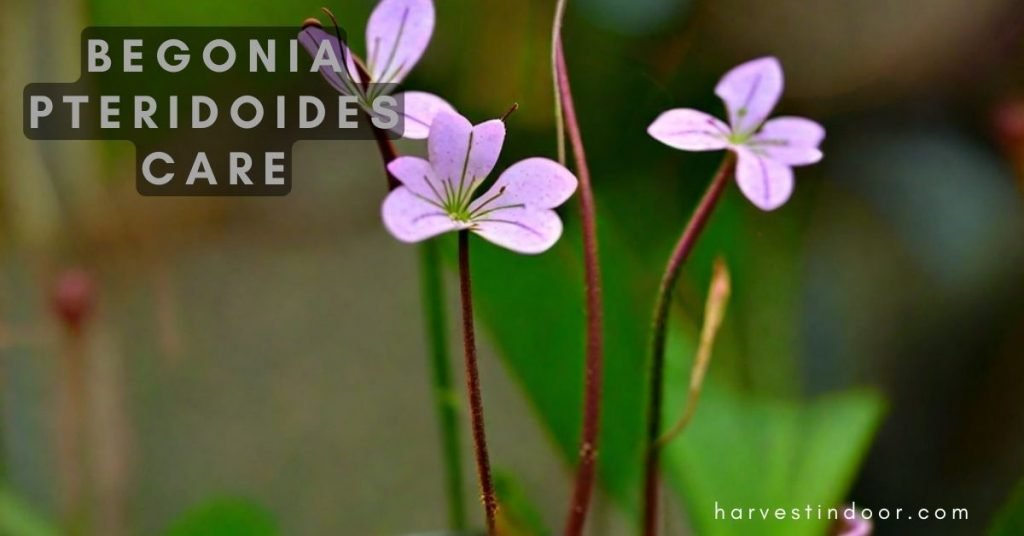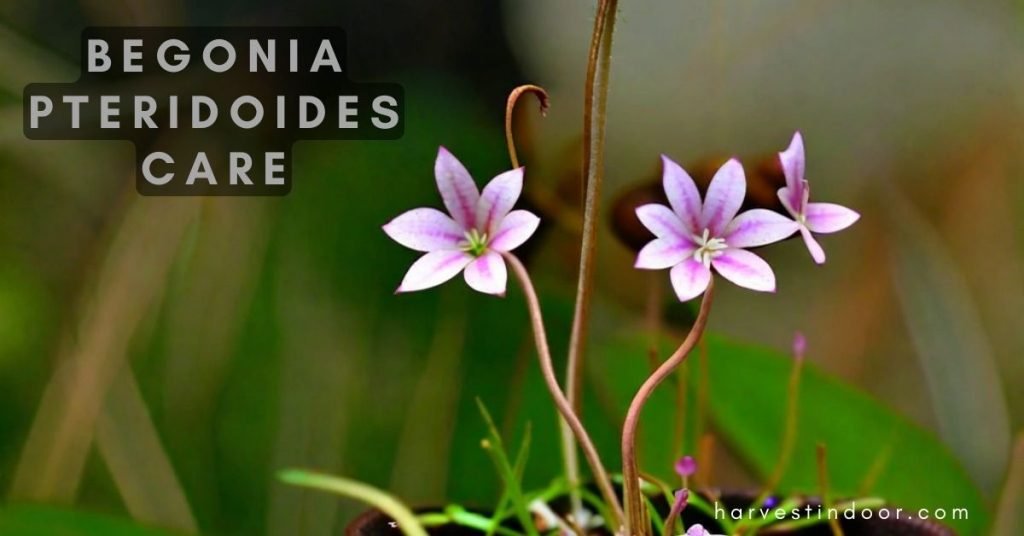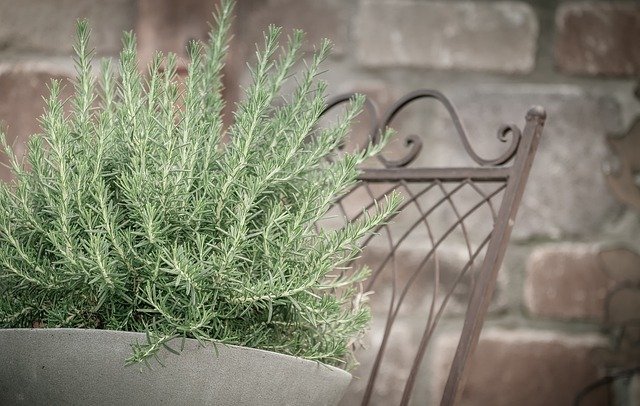Begonia pteridoides, commonly known as the “Begonia pteridoides Scherber,” is a new species found by David Scherberich and Jacky Duruisseau in 2017. Native to Nosy Mangabe in Madagascar, this begonia species belongs to the Begoniaceae family.

With its delicate, fern-like leaves and attractive blooms, Begonia pteridoides adds a touch of elegance and beauty to any garden or indoor space. In this comprehensive guide, we will explore the characteristics, cultivation techniques, care tips, and much more, allowing you to unlock the secrets of this fascinating plant.
Table of Contents
Begonia Pteridoides: An Overview
Begonia pteridoides is a species admired for its distinctive appearance. With its rare and cylinder leaves, this begonia species resembles the delicate roots or small trunks. The botanical name “pteridoides” is derived from the Greek word “pteris,” meaning wing or feather, which aptly describes the leaf structure of this begonia. The plant’s unique charm lies not only in its leaves but also in its attractive flowers, which range in color from white and pink to red and orange.
Characteristics of Begonia Pteridoides

Begonia pteridoides exhibits several noteworthy characteristics that make it a standout addition to any botanical collection or garden. Here are some key features:
- Leaf Structure: The leaves of pteridoides are one of its most striking attributes. Resembling roots or small trunk branches in many directions.
- Flowering Habit: This begonia species produces clusters of delicate flowers on arching stems. The blooms vary in color, ranging from white and pink to vibrant shades of red and orange. The flowers add a touch of elegance and vibrancy to the plant.
- Compact Growth: Begonia pteridoides typically grow in a compact and bushy manner, reaching a height of around 8 to 12 inches (20 to 30 cm). Its compact growth habit makes it suitable for both indoor and outdoor cultivation.
Cultivation of Begonia Pteridoides
Begonia can be successfully cultivated both indoors and outdoors, provided the appropriate conditions are met. Let’s delve into the cultivation techniques required to grow this fascinating new plant:
- Light Requirements: Begonia pteridoides thrives in bright, indirect light. It prefers a balance of sunlight and shade, making it ideal for areas with dappled light or partial shade. When grown indoors, placing the plant near a north or east-facing window can provide the right amount of light.
- Temperature Range: This begonia species prefers moderate temperatures, ranging from 60 to 75°F (15 to 24°C). It is essential to protect the plant from extreme heat or cold, as it can adversely affect its growth and overall health.
- Humidity Levels: Begonia pteridoides thrives in humid environments, mimicking its natural habitat in rainforests. To ensure the plant receives adequate moisture, consider placing it on a humidity tray or using a room humidifier.
- Soil Requirements: The ideal soil for Begonia pteridoides is well-draining and rich in organic matter. A mix of peat moss, perlite, and loamy soil provides the optimal growing medium for this begonia species.
- Pot Selection: When cultivating Begonia pteridoides indoors, choose a pot with drainage holes to prevent waterlogging. A shallow container with a diameter of 6 to 8 inches (15 to 20 cm) is typically sufficient to accommodate the plant’s compact growth habit.
Ideal Growing Conditions
To ensure the successful growth and development of Begonia pteridoides, it is crucial to provide the plant with the ideal growing conditions. Consider the following factors:
- Location: Select a location that offers the begonia a balance of sunlight and shade. Avoid direct exposure to intense sunlight, as it can scorch the delicate leaves.
- Watering: Begonia pteridoides prefers consistently moist soil. Water the plant thoroughly when the top inch (2.5 cm) of soil feels dry. Ensure proper drainage to prevent waterlogging, which can lead to root rot.
- Feeding: Fertilize Begonia pteridoides every two to four weeks during the growing season (spring and summer) using a balanced water-soluble fertilizer. Dilute the fertilizer to half the recommended strength to avoid overfeeding.
- Pruning: Regular pruning helps maintain the plant’s compact shape and encourages bushier growth. Remove any leggy or diseased stems to promote overall health.
Planting Begonia Pteridoides

Planting Begonia pteridoides is a straightforward process. Follow these steps to ensure successful establishment:
- Prepare the soil: Create a well-draining soil mix by combining equal parts of peat moss, perlite, and loamy soil.
- Select a pot: Choose a pot with drainage holes that are slightly larger than the root ball of the plant.
- Add soil to the pot: Fill the pot with the prepared soil mix, leaving enough space for the root ball.
- Remove the plant from its container: Gently tap the bottom of the container to loosen the plant’s root ball. Carefully lift the plant, holding it by the base of the stems.
- Place the plant in the pot: Position the plant in the center of the pot and ensure it is at the same depth it was previously growing.
- Fill the remaining space: Backfill the pot with the prepared soil mix, gently pressing it down to eliminate air pockets.
- Water thoroughly: After planting, water the begonia thoroughly to settle the soil and provide hydration to the roots.
- Maintain appropriate care: Follow the watering, feeding, and pruning guidelines discussed earlier to ensure the ongoing health of your Begonia pteridoides.
Watering and Moisture Requirements
Watering plays a vital role in the successful growth and development of Begonia pteridoides. Proper watering techniques ensure the plant receives adequate moisture without the risk of overwatering or underwatering. Here are some guidelines:
- Moisture Level: Begonia pteridoides prefers consistently moist soil. It is essential to maintain a balance, avoiding both waterlogged and excessively dry conditions.
- Watering Frequency: Water the plant thoroughly when the top inch (2.5 cm) of soil feels dry to the touch. Check the moisture level regularly to establish a watering routine that suits your specific environment.
- Watering Method: To prevent waterlogging, water the plant at the base, directing the water to the soil rather than splashing it on the leaves. This method also helps prevent fungal diseases.
Fertilizing Begonia Pteridoides
Proper fertilization provides Begonia pteridoides with essential nutrients for robust growth and vibrant blooms. Consider the following tips:
- Fertilizer Selection: Choose a balanced water-soluble fertilizer with equal proportions of nitrogen (N), phosphorus (P), and potassium (K). A fertilizer labeled 10-10-10 or 20-20-20 is suitable for Begonia pteridoides.
- Dilution Ratio: Dilute the fertilizer to half the recommended strength. Overfertilizing can lead to salt build-up and cause damage to the plant.
- Fertilizing Frequency: Apply the diluted fertilizer every two to four weeks during the growing season (spring and summer). Reduce or stop fertilization during the dormant period in winter.
- Application Method: Water the plant thoroughly before applying the fertilizer. Pour the diluted fertilizer onto the soil, avoiding direct contact with the leaves.
Pruning and Propagation
Pruning plays a crucial role in maintaining the overall health, shape, and compact growth of Begonia pteridoides. Additionally, propagating the plant allows you to expand your collection or share it with fellow gardening enthusiasts. Here’s what you need to know:
- Pruning: Regularly trim the plant to remove leggy or diseased stems. Use clean and sharp pruning shears to make precise cuts. Prune during the active growing season to encourage bushier growth.
- Propagation: Begonia pteridoides can be propagated through stem cuttings. Select a healthy stem with several leaves and make a clean cut just below a leaf node. Place the cutting in a well-draining rooting medium, such as a mixture of perlite and peat moss. Provide the cutting with high humidity and bright, indirect light until it develops roots.
Common Pests and Diseases
While Begonia pteridoides is generally a resilient plant, it can be susceptible to certain pests and diseases. Here are some common issues to watch out for:
- Pest Infestations: The plant may attract pests like aphids, spider mites, and mealybugs. Regularly inspect the leaves for signs of infestation, such as webs or tiny insects. Treat the affected plant using organic insecticidal soap or neem oil.
- Fungal Diseases: Begonia pteridoides can be vulnerable to fungal diseases, including powdery mildew and leaf spot. Ensure proper air circulation around the plant, avoid overhead watering, and maintain appropriate humidity levels to minimize the risk.
Troubleshooting
When cultivating Begonia pteridoides, you may encounter certain issues that can affect its growth and overall well-being. Here are some troubleshooting tips:
- Yellowing Leaves: Yellowing leaves can indicate overwatering or insufficient drainage. Adjust your watering routine and ensure the soil is well-draining.
- Leggy Growth: Insufficient light can cause the plant to grow leggy or elongated stems. Move the plant to a brighter location to promote compact growth.
- Leaf Browning: Leaf browning can be a result of direct exposure to intense sunlight or inadequate humidity levels. Adjust the plant’s location or increase humidity to address the issue.
Frequently Asked Questions (FAQs)
Q: How often should I water Begonia pteridoides?
Water Begonia pteridoides when the top inch (2.5 cm) of soil feels dry. Aim for consistent moisture without waterlogging.
Q: Can Begonia pteridoides tolerate direct sunlight?
Begonia pteridoides prefers bright, indirect light or partial shade. Direct exposure to intense sunlight can scorch its delicate leaves.
Q: How tall does Begonia pteridoides grow?
Begonia pteridoides typically reaches a height of around 8 to 12 inches (20 to 30 cm), making it a compact and suitable choice for indoor cultivation.
Q: How often should I fertilize Begonia pteridoides?
Fertilize Begonia pteridoides every two to four weeks during the growing season (spring and summer) using a balanced water-soluble fertilizer. Dilute the fertilizer to half the recommended strength.
Q: Can I propagate Begonia pteridoides from cuttings?
Yes, Begonia pteridoides can be propagated through stem cuttings. Select a healthy stem and place it in a well-draining rooting medium until roots develop.
Q: How can I prevent pests and diseases in Begonia pteridoides?
Regularly inspect the plant for pests and provide appropriate care to minimize the risk of infestation. Ensure proper air circulation, avoid overwatering, and maintain suitable humidity levels to prevent fungal diseases.
Conclusion
Begonia pteridoides, with its captivating foliage and vibrant blooms, add a touch of elegance and beauty to any garden or indoor space. By understanding its characteristics, cultivation techniques, and care requirements, you can create an environment in which this fascinating plant thrives. Whether you choose to grow it as an indoor companion or showcase it in an outdoor garden, Begonia pteridoides will undoubtedly captivate you with its unique charm and stunning beauty.

Gardening is my passion and growing plants indoors has always been a stress relief for me. Grow a banana tree in my apartment once (although failed to produce bananas).







I have searched so many times for information on how to grow begonia Pteridoides but have not found any. I was very happy when I found information. A question I have since I can’t get hold of this begonia in the EU. I can buy seeds but what should you think about when sowing seeds from this gorgeous variety?
Thank you once again.
Hello!
For those in Sweden, given the colder climate, consider starting the seeds indoors or in a greenhouse to provide the warmth and consistent conditions Begonia Pteridoides prefers. Additionally, during the darker months, you might want to supplement with artificial lighting to ensure adequate light for germination and growth. Remember to adjust watering to the indoor environment. Best wishes with your gardening journey in Sweden! 🌱🇸🇪
Thanks for this through information 😁